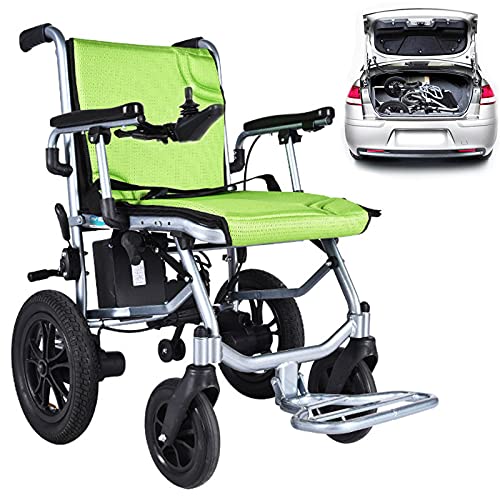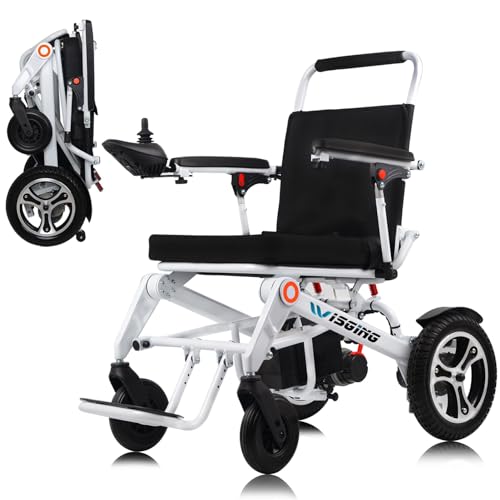15 Gifts For The Electric Wheelchair With Joystick Lover In Your Life
페이지 정보

본문
 transportable electric wheelchair - he said, Wheelchair With Joystick
transportable electric wheelchair - he said, Wheelchair With Joystick Joysticks in power wheelchairs can greatly increase independence and ease of use. However, standard joysticks might be incompatible with the individualized features of hand disorders.
Joysticks in power wheelchairs can greatly increase independence and ease of use. However, standard joysticks might be incompatible with the individualized features of hand disorders.This study examined the efficacy and satisfaction of custom-designed power wheelchair joysticks fabricated with 3D printing technology. The test was conducted using modified power-mobility inside driving assessment (PIDA), National Aeronautics and Space Administration Task Load Index and Psychosocial Impact of Assistive Devices Scale.
Control
The control system for a power chair has two key components: the joystick and the electronic. The standard joysticks are placed on either the left or right side of the wheelchair, whereas more complicated rehab chairs have swing-away mounts that allow the joystick to be moved to the middle of the seat.
The way in which a joystick will be mounted and used is crucial to its effectiveness for a user. For example when a person has significant tremors, it is crucial to ensure the joystick is designed such a way that the movements do not trigger accidental activations of the chair. Standard EPW joysticks are proportional input devices that react to the deflection of the gimbal to control the chair's motion (similar to the video game controller or an accelerator in a car pedal).
There are numerous alternative control options available for power wheelchairs that require very only a little force to activate. Switch controls, sip-and-puff controls head arrays, sip-and-puff controls, and chin controls are all accessible. Some of these controls require an additional interface to connect to the wheelchair. However, most of them can be used with new joysticks that incorporate Bluetooth into the handles.
Some of the standard wheelchair joysticks have a screen on them to show the status of the system and provide feedback to the user, which is particularly beneficial for people who have cognitive or visual impairments. Certain advanced joysticks are able to control many different accessories such as televisions, environmental controls and tablet.
No matter what technology is used, a joystick can only be as effective if it is comfortable for the user operate. It is therefore crucial to think about the size of the buttons as well as their placement on the joystick to make them easily accessible. It is also important to take into consideration the sensitivity of the joystick, which can be set to a range of levels based on the specific needs of the user.
Comfort
A joystick-controlled wheelchair comes with many advantages that manual chairs do not offer. They reduce fatigue due to operational factors and can travel for longer distances than manual chairs. They can also be used in locations with fewer spaces and more difficult terrain than a manual one, for example, uneven surfaces or slopes in the outdoors. With this added independence users will experience the freedom of movement that brings new life to their lives and reminds users of the feeling to be independent once more.
A variety of different powered wheelchairs are available with an array of options. The number of bells and whistles the particular model comes with will depend on what the user wants and needs. The most commonly used features include:
Controls on an lightest electric wheelchair wheelchair with joystick can be customized to meet your individual requirements. This includes the type of knob or handle, or ball, and the manner in which it is mounted. Some joysticks are placed at the end of the armrest that is dominant, while others are placed in the front or back of the seat for easy access by the attendant. Certain joysticks can be placed on the side for those who have limited shoulder range or muscular weakness.
Other features are more personalised including the design and size of the joystick's display. Certain models are backlit or have the color of the screen, which makes it easier for people with low-vision to read. Other models have auxiliary modes that offer audio or visual clues to aid in navigation. Other models could include odometers, clocks, and battery charge indicators.
The ability of a joystick to maneuver in a limited turning radius is also important. The best-performing models will have a narrow turning radius that allows for easier navigation of obstacles in small spaces, such as hallways. The tight turning radius also allows for easier maneuvering in public spaces and in stores. This tight turning circle is especially beneficial for those suffering from mobility issues, such as cerebral palsy or other mobility issues, like multiple sclerosis, ALS and Huntington's Disease. brainstem injury or spinal cord stroke.
Safety
power chairs for disabled wheelchairs were made with safety in mind as a priority. They are equipped with reliable brake systems that can limit the speed rapidly when the consumer presses the joystick control. They also have anti-tip wheels in the rear that help stop the chair from sliding backward.
The most common joystick type is a proportional control. It is similar to video game controllers and accelerator pedals for cars, in that it makes the wheelchair move faster the further it is from the center. These types of joysticks need proprioception and finger dexterity to function effectively. A standard joystick is typically placed on the armrest, however, a variety of specialty controls are available that put the controls in the middle or on the side of the seat.
Certain people might not have the strength to deflect a joystick's handle, even with the help of special rigging. People with spasticity might be a bit troubled due to their muscles becoming stiff or atrophy. In these cases it might be beneficial to use a head-control unit that converts the movements of the user's body into the required commands for the wheelchair.
The size and location of the joystick's buttons is another factor to consider. If the buttons are far to the left or difficult to reach, they could affect the seating position of the user, and cause stress on the hands. If the joystick is placed too far back, it may be difficult to move the chair or turn the wheels.
Lastly, an electric wheelchair must always be used with a seatbelt secured. Seatbelts must be secured when using an light electric wheelchair wheelchair. The fastest wheelchairs can travel up to 8mph. It is also crucial to charge batteries regularly, every at night, if you can. This will allow them to live longer and maintain their effectiveness. It's also an excellent idea to schedule regular maintenance on your chair to make sure the components are in good working order.
Accessories
The joystick is a major element of any power wheelchair and there are many accessories that can be added to enhance its capabilities. These range from simple switches to more sophisticated interfaces that can be connected to communication devices or even external environmental control units. Higher-end power wheelchairs will often come with a variety controller components that can meet the requirements of different users. For example, a non-expandable controller will typically accept a proportional joystick for an input device. However, an expandable controller may allow for sip and puff controls, specialty switches, and head array systems. Some of the more sophisticated controllers can even use up to two power seating actuators that can be used to adjust the position and tilt of the seat.
The most basic kind of joystick that is commonly used in the clinic is a proportional control, sometimes called a movement sensing joystick. This type of joystick responds the force by increasing output (i.e. the speed of the wheelchair) the further the stick is pushed away from the center. This requires a lot of dexterity and intact proprioception for effective use.
While the technology in use today can compensate for small variations in amplitude during EPW driving but it is not able to recognize and adjust to more severe and unintentional movements, like those caused by larger involuntary or amplitude tremors that are not accompanied by conscious intent like athetosis.5 As long as we don't develop and implement new technologies that can accurately detect and adapt to these kinds of unintentional movements, a lot of sufferers with diseases such as athetosis, MS, ALS or spinal cord injury will not be able to safely use an light electric wheelchairs power chair.
Most wheelchairs have a number of parameters that can be programmed and customized, usually with the help of a physician. These parameters include changing the torque generated by the motor, and adjusting the speed of the chair. They can be used to set the dead zone, which is the distance in which the EPW isn't able to produce output. Certain controllers will also have the ability to store backup programs, which is useful for a healthcare professional to keep in the event of an emergency or for clients with varying symptoms.
- 이전글Why You Should Focus On Enhancing Audi Spare Key 24.11.09
- 다음글The Leading Reasons Why People Achieve In The Espresso Machines Industry 24.11.09
댓글목록
등록된 댓글이 없습니다.



